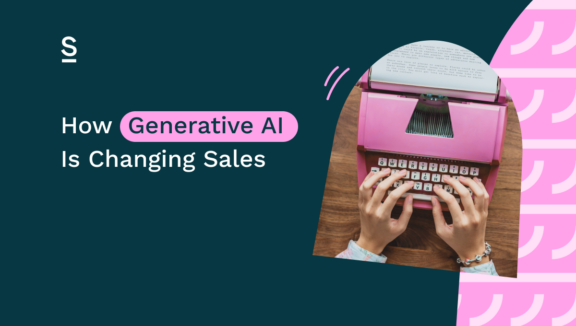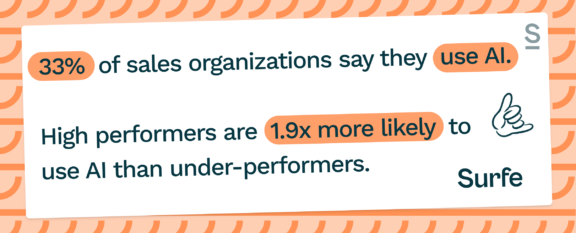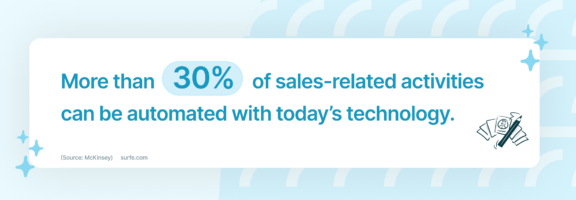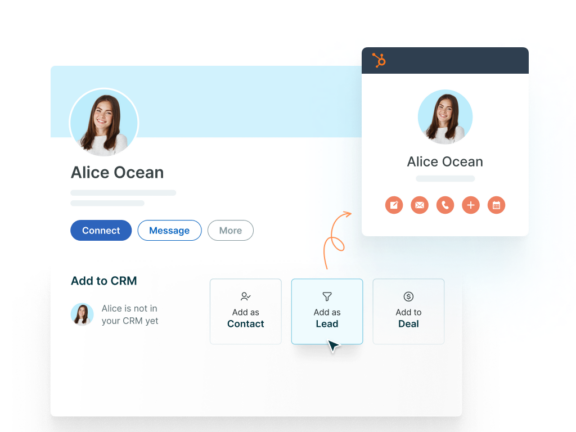How Generative AI Is Changing Sales

There are hundreds, if not thousands, of new AI tools being adopted in sales right now – a major shift in how to perform and succeed in sales.
AI business opportunities promise to scale content creation, streamline sales processes, and improve overall levels of efficiency – so where will AI provide the most value and what areas will remain at the hands of human SDRs and BDRs?
Sales is all about relationships and understanding subtle cues, something computers couldn’t quite grasp, until now. Generative AI, like the tech powering ChatGPT and Google’s Gemini, is changing the game. It’s designed to learn and understand the nuances of human language and interaction, making it a perfect partner for sales.
For the first time, salespeople have access to technology that can genuinely understand and enhance some human elements of their job.
This article looks at how AI is being applied to sales now, and where it could go in the future.
Key highlights:
A Quick Summary of Generative AI and Sales
Generative AI works best when it has lots of data to learn from, and every sales journey has valuable data. From email exchanges and hours of phone conversations, to the data in your CRM about sales cycles, deal sizes, and other quantitative data. AI can learn from all of this and make improvements along the way.
The benefit of AI is not just that it processes data, but that it uses that data to help salespeople forge stronger connections with their customers and close more deals. By analyzing and learning from each interaction, generative AI can offer suggestions that are personalized to that specific customer, making each one feel understood and catered to.

Challenges with AI in Sales
While the promise of generative AI in sales is undoubtedly exciting, integrating it into existing sales workflows isn’t without its challenges. The key to unlocking generative AI’s potential lies in utilizing it in a way that feels natural and enhances the sales process without disrupting it. This means finding a balance between leveraging AI’s capabilities and maintaining the human touch.
Integrating AI into an existing sales ecosystem
Salespeople should feel that AI is a helper, not a hindrance. It’s no good if your AI tools aren’t blending seamlessly with your daily sales activities. This integration is crucial for wide-spread adoption. Its still a challenge for AI to fully aid salespeople in their tasks without complicating them or adding another layer of admin to an already busy schedule. Of course, sometimes it can totally revolutionize your processes, but sometimes it just doesn’t quite hit the mark.
AI errors
Generative AI, for all its intelligence, is not perfect. If you’ve spent time using ChatGPT or Gemini at all, you’ll know that they can sometimes produce inaccurate outcomes or exhibit biases, which are reflections of the data it was trained on.
Ask AI to count, mention specific dates, or provide accurate sources – it often struggles.
These inaccuracies and biases can be particularly problematic in sales, where understanding and relating to diverse customer bases is essential. To mitigate these issues, generative AI models require customization and fine-tuning to the specific contexts and needs of each sales team. It also means every AI action needs a level of review. This can be resource-intensive.
Benefits of Generative AI in Sales
Reducing admin and manual tasks to save time
One of the most immediate benefits of generative AI is its ability to take on the burden of administrative tasks that often bog down sales teams.
For example, when it comes to drafting emails or updating CRM entries (hint, hint: check out the Surfe integration between your CRM, like Pipedrive, and LinkedIn), AI can help you. These necessary but time-consuming tasks can cut into the time you could be using to make sales.
Enhancing Customer Interactions
The connection between the salesperson and the customer is what closes deals. Generative AI has the power to deepen these connections by providing personalized content and highly tailored recommendations using the best AI tools, based on an analysis of customer data, including past interactions, preferences, and behaviors.
What’s more, generative AI can pick up on the subtleties of customer sentiment, like the mood of an email or a social media post, and refine the recommendations it makes. This level of personalization can significantly enhance the quality of customer interactions.
Assisting Sales Managers
Sales managers stand to gain enormously from the adoption of generative AI. Beyond direct sales interactions, AI can change how sales performance is managed.
Traditional reporting systems, while informative, often provide a rear-view mirror perspective, focusing on what has already happened. Generative AI can transform these systems into forward-looking tools that offer actionable insights and forecasts.
But then it’s over to the sales managers to use these insights to craft more effective sales strategies and make informed decisions about resource allocation – there’s that mix between AI input and human output.

How AI can provide the most value in Sales
The beauty of generative AI is that it doesn’t require a complete overhaul of your existing sales systems. In fact, one of the quickest paths to value is integrating AI capabilities into the tools your team already uses daily.
When done correctly, it minimizes disruption and avoids the steep learning curves associated with adopting entirely new software. By enhancing familiar platforms with AI-driven functionalities, like CRM integrations for LinkedIn, sales teams can start seeing benefits almost immediately. It’s about making the tools that already work for you work harder, and smarter, not replacing them altogether.
Controlling Costs
When AI saves you time, it saves you money. The time you spend on manual admin tasks isn’t free. You’re paid a salary and when you look at how many hours per week, per month, and per year that you spend on these manual tasks… it quickly adds up.
By handing these manual admin tasks over to an AI powered tool, you’re essentially freeing up all these hours for you to spend on higher priority tasks like lead generation.
It’s not just time that AI can save either. It can also reduce the size of your tech stack. Many AI tools are handling multiple tasks. This can often mean one AI tool can do the same, if not better job, that two or three regular tools can do.
But if AI is analyzing your data, providing forecasting, and enhancing your sales strategy, it’s going to close more deals for you – at least that’s the intention.
The key is to calculate the ROI of having an AI tool: how much time will it save you, how will it increase your sales, and what will be the impact on your bottom line? If the monetary benefit of adopting an AI tool greatly outweighs the cost of implementing it, it can indicate a significant ROI.
AI as a Productivity Aid vs Substitute
If you’ve read this far, you’ll have noticed a distinction emerging between viewing AI as a tool to augment human capabilities, or seeing it as a replacement for them.
So is AI going to replace your job? No. Don’t believe the click-bait articles and fear-mongering. The future of AI in sales I is not one where sales professionals are sidelined: but it is important that you learn to adopt AI and implement it into your processes.
When it comes to employment opportunities and career development, the candidate with a greater ability to adopt AI and work more efficiently with it will be the most employable.
Generative AI as an assistant
We’re seeing that AI can boost productivity without replacing the human element that’s so crucial to sales. From automating administrative tasks to offering smart, data-driven suggestions for customer interactions, AI enables sales teams to focus on what truly matters: building relationships and closing deals.
And if you think about it, this is essentially the role of an assistant. Reading documents you don’t have time to analyze, crunching numbers, taking notes, proof reading your content: let AI work as your assistant – again, not replacing you, but enhancing your ability to perform.
Let’s wrap it up!
The true value of adopting AI lies in using it to augment your capabilities as a salesperson.
AI is changing how we manage the workload of administrative and manual tasks and you need to learn to adopt it to stay ahead.
There remain challenges posed by adopting AI, but given the potential ROI of some AI tools, it’s worth calculating the impact of certain tools that can save you time, increase data accuracy, and help you close more deals.

Saving time with AI? Save more when you connect your CRM to LinkedIn
And we’ll give you 20 free credits for finding the email addresses of your prospects too!
FAQs about Generative AI and Sales
What are the key features to look for in a generative AI tool for sales?
Key features include natural language processing capabilities, customization options, data analysis and reporting functionalities, and seamless integration with existing sales tools and CRM systems.
What are the first steps to integrating generative AI into existing sales processes?
Start with a clear assessment of your sales processes to identify areas where AI can have the most impact. Next, choose a pilot project for AI integration, ensuring it’s scalable and aligned with your sales objectives. Finally, partner with AI solution providers or internal IT teams to integrate AI tools seamlessly into your existing systems.
What kind of training do sales teams need to effectively use generative AI tools?
Sales teams need training on how to interact with AI tools, interpret AI-generated insights, and apply these in their sales processes. This can include hands-on workshops, e-learning modules, and ongoing support to ensure proficiency and confidence in using AI technologies. But most AI tools are developed to require as little training and onboarding as possible. Before adopting a new tool, you should always assess the required time spent on training and calculate an ROI.
How can organizations encourage adoption among sales professionals who may be resistant to new technologies?
Highlight the benefits of AI tools, such as reducing administrative workload and enhancing customer engagement. Encourage a culture of innovation, and involve sales professionals in the selection and implementation process to ensure the solutions meet their needs and preferences. Case studies of successful sales that have used AI may be helpful, as well as testimonials from team members who have hit their targets thanks to early adoption of AI.
How can generative AI be customized for specific industries or customer segments?
Customization involves training the AI on industry-specific data and incorporating feedback loops to refine its outputs based on real-world interactions. Collaboration with AI developers can help tailor AI functionalities to suit specific customer segments and industry requirements.
What measures are necessary to ensure customer data used by AI remains secure?
Implement robust data encryption, access controls, and regular security audits. Compliance with data protection regulations and ethical guidelines is crucial to safeguarding customer information. When you’re selecting the tools you use, always ensure they’re ISO27001 certified and GDPR compliant.
How can organizations evaluate and choose the right generative AI solutions for their sales teams?
Assess solutions based on criteria like ease of integration, user-friendliness, scalability, and the provider’s expertise in your industry. Consider conducting pilots or trials to test the solution’s effectiveness in addressing your specific sales challenges.
How can the impact of generative AI on sales performance and productivity be measured?
Measure impact through metrics such as time saved on administrative tasks, improvement in lead conversion rates, customer satisfaction scores, and overall sales growth. Establish baseline metrics before AI integration for accurate assessment. KPIs such as increased sales revenue, higher lead qualification rates, reduced sales cycle lengths, and improved accuracy in sales forecasting.


